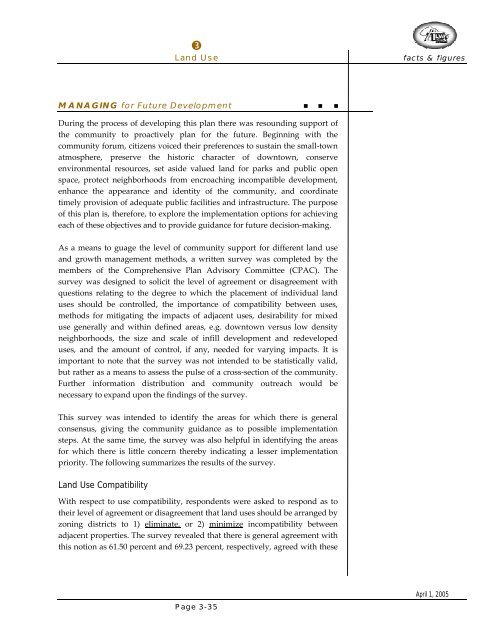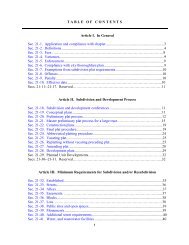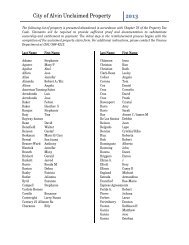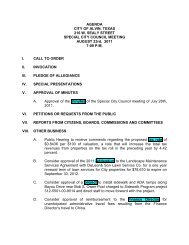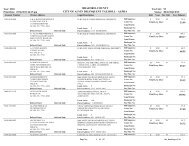Comprehensive Master Plan - City of Alvin
Comprehensive Master Plan - City of Alvin
Comprehensive Master Plan - City of Alvin
- No tags were found...
Create successful ePaper yourself
Turn your PDF publications into a flip-book with our unique Google optimized e-Paper software.
Land Usefacts & figuresMANAGING for Future Development • • •During the process <strong>of</strong> developing this plan there was resounding support <strong>of</strong>the community to proactively plan for the future. Beginning with thecommunity forum, citizens voiced their preferences to sustain the small‐townatmosphere, preserve the historic character <strong>of</strong> downtown, conserveenvironmental resources, set aside valued land for parks and public openspace, protect neighborhoods from encroaching incompatible development,enhance the appearance and identity <strong>of</strong> the community, and coordinatetimely provision <strong>of</strong> adequate public facilities and infrastructure. The purpose<strong>of</strong> this plan is, therefore, to explore the implementation options for achievingeach <strong>of</strong> these objectives and to provide guidance for future decision‐making.As a means to guage the level <strong>of</strong> community support for different land useand growth management methods, a written survey was completed by themembers <strong>of</strong> the <strong>Comprehensive</strong> <strong>Plan</strong> Advisory Committee (CPAC). Thesurvey was designed to solicit the level <strong>of</strong> agreement or disagreement withquestions relating to the degree to which the placement <strong>of</strong> individual landuses should be controlled, the importance <strong>of</strong> compatibility between uses,methods for mitigating the impacts <strong>of</strong> adjacent uses, desirability for mixeduse generally and within defined areas, e.g. downtown versus low densityneighborhoods, the size and scale <strong>of</strong> infill development and redevelopeduses, and the amount <strong>of</strong> control, if any, needed for varying impacts. It isimportant to note that the survey was not intended to be statistically valid,but rather as a means to assess the pulse <strong>of</strong> a cross‐section <strong>of</strong> the community.Further information distribution and community outreach would benecessary to expand upon the findings <strong>of</strong> the survey.This survey was intended to identify the areas for which there is generalconsensus, giving the community guidance as to possible implementationsteps. At the same time, the survey was also helpful in identifying the areasfor which there is little concern thereby indicating a lesser implementationpriority. The following summarizes the results <strong>of</strong> the survey.Land Use CompatibilityWith respect to use compatibility, respondents were asked to respond as totheir level <strong>of</strong> agreement or disagreement that land uses should be arranged byzoning districts to 1) eliminate, or 2) minimize incompatibility betweenadjacent properties. The survey revealed that there is general agreement withthis notion as 61.50 percent and 69.23 percent, respectively, agreed with thesePage 3-35April 1, 2005


